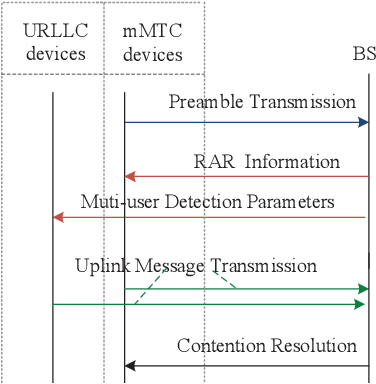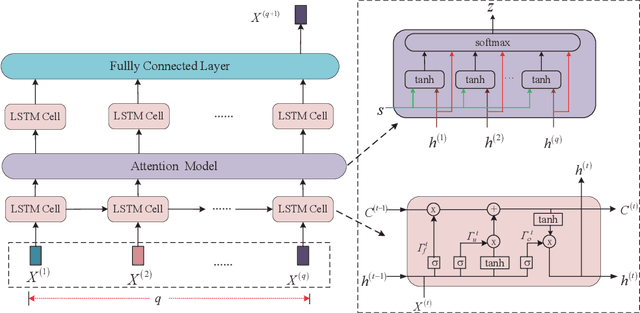Liping Qian
Scalable Multi-task Edge Sensing via Task-oriented Joint Information Gathering and Broadcast
Apr 16, 2025Abstract:The recent advance of edge computing technology enables significant sensing performance improvement of Internet of Things (IoT) networks. In particular, an edge server (ES) is responsible for gathering sensing data from distributed sensing devices, and immediately executing different sensing tasks to accommodate the heterogeneous service demands of mobile users. However, as the number of users surges and the sensing tasks become increasingly compute-intensive, the huge amount of computation workloads and data transmissions may overwhelm the edge system of limited resources. Accordingly, we propose in this paper a scalable edge sensing framework for multi-task execution, in the sense that the computation workload and communication overhead of the ES do not increase with the number of downstream users or tasks. By exploiting the task-relevant correlations, the proposed scheme implements a unified encoder at the ES, which produces a common low-dimensional message from the sensing data and broadcasts it to all users to execute their individual tasks. To achieve high sensing accuracy, we extend the well-known information bottleneck theory to a multi-task scenario to jointly optimize the information gathering and broadcast processes. We also develop an efficient two-step training procedure to optimize the parameters of the neural network-based codecs deployed in the edge sensing system. Experiment results show that the proposed scheme significantly outperforms the considered representative benchmark methods in multi-task inference accuracy. Besides, the proposed scheme is scalable to the network size, which maintains almost constant computation delay with less than 1% degradation of inference performance when the user number increases by four times.
Digital Semantic Communications: An Alternating Multi-Phase Training Strategy with Mask Attack
Aug 09, 2024Abstract:Semantic communication (SemComm) has emerged as new paradigm shifts.Most existing SemComm systems transmit continuously distributed signals in analog fashion.However, the analog paradigm is not compatible with current digital communication frameworks. In this paper, we propose an alternating multi-phase training strategy (AMP) to enable the joint training of the networks in the encoder and decoder through non-differentiable digital processes. AMP contains three training phases, aiming at feature extraction (FE), robustness enhancement (RE), and training-testing alignment (TTA), respectively. AMP contains three training phases, aiming at feature extraction (FE), robustness enhancement (RE), and training-testing alignment (TTA), respectively. In particular, in the FE stage, we learn the representation ability of semantic information by end-to-end training the encoder and decoder in an analog manner. When we take digital communication into consideration, the domain shift between digital and analog demands the fine-tuning for encoder and decoder. To cope with joint training process within the non-differentiable digital processes, we propose the alternation between updating the decoder individually and jointly training the codec in RE phase. To boost robustness further, we investigate a mask-attack (MATK) in RE to simulate an evident and severe bit-flipping effect in a differentiable manner. To address the training-testing inconsistency introduced by MATK, we employ an additional TTA phase, fine-tuning the decoder without MATK. Combining with AMP and an information restoration network, we propose a digital SemComm system for image transmission, named AMP-SC. Comparing with the representative benchmark, AMP-SC achieves $0.82 \sim 1.65$dB higher average reconstruction performance among various representative datasets at different scales and a wide range of signal-to-noise ratio.
Filling the Missing: Exploring Generative AI for Enhanced Federated Learning over Heterogeneous Mobile Edge Devices
Oct 29, 2023



Abstract:Distributed Artificial Intelligence (AI) model training over mobile edge networks encounters significant challenges due to the data and resource heterogeneity of edge devices. The former hampers the convergence rate of the global model, while the latter diminishes the devices' resource utilization efficiency. In this paper, we propose a generative AI-empowered federated learning to address these challenges by leveraging the idea of FIlling the MIssing (FIMI) portion of local data. Specifically, FIMI can be considered as a resource-aware data augmentation method that effectively mitigates the data heterogeneity while ensuring efficient FL training. We first quantify the relationship between the training data amount and the learning performance. We then study the FIMI optimization problem with the objective of minimizing the device-side overall energy consumption subject to required learning performance constraints. The decomposition-based analysis and the cross-entropy searching method are leveraged to derive the solution, where each device is assigned suitable AI-synthesized data and resource utilization policy. Experiment results demonstrate that FIMI can save up to 50% of the device-side energy to achieve the target global test accuracy in comparison with the existing methods. Meanwhile, FIMI can significantly enhance the converged global accuracy under the non-independently-and-identically distribution (non-IID) data.
LSTM-Aided Hybrid Random Access Scheme for 6G Heterogeneous MTC Networks
Dec 25, 2020



Abstract:An LSTM-aided hybrid random access scheme (LSTMH-RA) is proposed to support diverse quality of service (QoS) requirements in 6G MTC heterogeneous networks where URLLC and mMTC devices coexist. This scheme employs an attention-based LSTM prediction model to predict the number of active URLLC devices, determines the parameters of the multi-user detection algorithm dynamically, and then allows URLLC devices to access the network via a two-step contention-free access procedure, to meet latency and reliability access requirements; mMTC devices access the network via a contentionbased TA-aided access mechanism to meet massive access requirement. We analyze the successful access probability of the LSTMH-RA scheme. Numerical results show that, compared to the benchmark schemes, the LSTMH-RA scheme significantly improves the successful access probability, and satisfies the diverse QoS requirements of URLLC and mMTC devices
 Add to Chrome
Add to Chrome Add to Firefox
Add to Firefox Add to Edge
Add to Edge